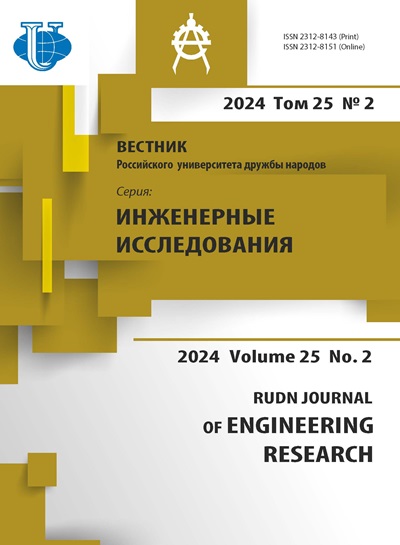Investigation of the Effect of Thermal Cycling on the Magnetic and Mechanical Properties of Steels
- Authors: Kornilova A.V.1
-
Affiliations:
- National Research Moscow State University of Civil Engineering
- Issue: Vol 25, No 2 (2024)
- Pages: 140-150
- Section: Articles
- URL: https://journals.rudn.ru/engineering-researches/article/view/40359
- DOI: https://doi.org/10.22363/2312-8143-2024-25-2-140-150
- EDN: https://elibrary.ru/GSPCLR
Cite item
Full Text
Abstract
Currently, throughout the world, thermal cycling processes are recognized as the most effective ways to increase the durability of metalworking tools. However, this promising technology has been little studied for structural steels. But the question of the influence of thermal cycling on magnetic properties (coercive force) has practically not been raised in the scientific literature. Therefore, in this work, the goal was to study the change in the coercive force and hardness of steels when using various thermal cycling schemes. During the experiments, steels of various purposes (structural and instrumental) and chemical composition were investigated. The following were studied: - pendulum, lowtemperature, medium-temperature, high-temperature thermal cycling and thermal cycling near the Curie temperature of cementite. All standard types of thermal cycling showed a drop in coercive force. Thermal cycling for carbon structural steel was carried out near the Curie point of cementite. The steel showed a jump in properties during the third cycle. A study of the structure revealed that partial spheroidization of pearlite occurred despite the fact that thermal cycling took place below the line of phase transformations. Research has shown that granular pearlite has a significantly greater coercive force than lamellar pearlite. The issue needs further research, and the phenomenon must find its practical application.
About the authors
Anna V. Kornilova
National Research Moscow State University of Civil Engineering
Author for correspondence.
Email: anna44@yandex.ru
ORCID iD: 0000-0001-5569-9320
SPIN-code: 6569-6240
Doctor of Technical Sciences, Professor of the Department of Testing of Structures
Moscow, RussiaReferences
- Argunova AA. Structural changes and mechanical properties of low-alloy steels and their welded joints after thermocyclic processing (dissertation of the Candidate of Technical Sciences: 02/05/01: defended 12/14/2000: approved. 06/20/2001. Yakutsk; 2000. (In Russ.)
- Jha SR, Ardham S, Tennyson G, Gurao NP, Biswas K. An experimental and computational framework to investigate the thermal cycling approach for strengthening low SFE FeMnNi medium entropy alloy. Materialia. 2023; 32:101937. https://doi.org/10.1016/j.mtla.2023.101937
- Luders C, Kalinka G, Li W, Sinapius M, Wille T. Experimental and numerical multiscale approach to thermally cycled FRP. Composite Structures. 2020;244:112303. https://doi.org/10.1016/j.compstruct.2020.112303
- Shmatov AA. Methods of hardening processing of metalworking tools. International Journal of Applied and Fundamental Research. 2021;8:59–63. (In Russ.)
- Shmatov AA, Shoosh L, Kraini Z. Practical application of the technology of combined hardening processing of steel tools. Materials Science. 2023;9:15 (In Russ.) http//doi.org/10.31044/1684-579X-2023-0-9-15-21
- Shmatov AA. Computer modeling of strengthening thermal cyclic treatment of eutectoid steel. International Journal of Applied and Fundamental Research. 2021;6:82–86. (In Russ.)
- Kornilova AV, Kyaw Z. The influence of heating temperature on coercive force and hardness changes in carbon hypoeutectoid steels. RUDN Journal of Engineering Research. 2022;23(2):140–145. http://doi.org/10.22363/2312-8143-2022-23-2-140-145
- Zaya K, Paing T, Kornilova AV. The effects of operational thermal cycling on mechanical and magnetic properties of structural steels. IOP Conference Series: Materials Science and Engineering. 2019;675:1. https://doi.org/10.1088/1757-899X/675/1/012041
- Kornilova AV, Idarmachev IM, Thet Paing M, Zhuo Zayar M. Method of hardening low- and mediumcarbon steels. Patent No. 2701239 C1 Russian Federation, IPC C21D 1/78.: application. 09.20.2018. 2019. (In Russ.)
- Chiou Wun CJr, Carter Emily A. Structure and stability of Fe3 C-cementite surfaces from first principles. Surface Science. 2003;530(1–2):88–100. http://doi.org/10.1016/s0039-6028(03)00352-2
- Wall AN, Rastegin AE, Perevalova IA. Physical kinetics. Irkutsk: ISU Publishing House; 2014.
- Bosov AD, Orlov YuN. Empirical Fokker-Planck equation for non-stationary time series. Preprint of IPM im. M.V. Keldysh RAS. 2013;3. (In Russ.) Available from: http://library.keldysh.ru/preprint.asp?id=2013-3 (accessed: 12.01.2024)
- Stashkov AN, Schapova EA, Afanasiev SV, Stashkova LA, Nichipuruk AP. Estimation of residual stresses in plastically deformed eutectoid steel with different perlite morphology via magnetic parameters. Journal of Magnetism and Magnetic Materials. 2022; 546:168850. http//doi.org/10.1016/j.jmmm.2021.168850
- Stashkov AN, Schapova EA, Nichipuruk AP., Korolev AV. Magnetic incremental permeability as indicator of compression stress in low-carbon steel. NDT & E International. 2021;118:102398. http//doi.org/10.1016/j.ndteint.2020.102398
- Nichipuruk AP, Stashkov AN, Shchapova EA, Kazantseva NV, Makarova MV. Structure and magnetic properties of 09G2S steel produced by selective laser alloying. Solid State Physics. 2021;63(11):1719–1724. (In Russ.) Available from: https://journals.ioffe.ru/articles/viewPDF/51567 (accessed: 12.01.2024)















